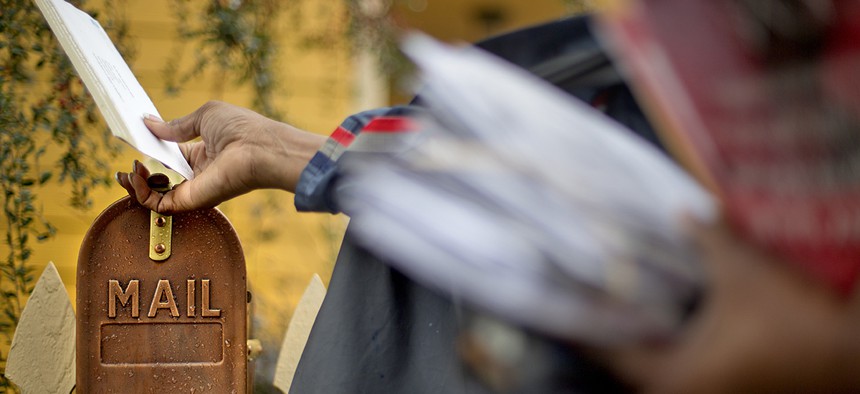Why the U.S. Postal Service Has the Best Customer Service in Government

U.S. Postal Service letter carrier, Jamesa Euler, delivers mail, in Atlanta. David Goldman/AP File Photo
The agency's "customer-obsessed" approach ranks highest in the federal government alongside the National Park Service.
Each year, the intrepid 600,000-strong workforce at the United States Postal Services braves dangerous weather and unfriendly canines to deliver some 155 billion pieces of mail to its customers.
Given the sheer size of the Postal Services operation – it processes 40 percent of the world’s entire volume of snail mail – conventional logic suggests USPS might struggle serving customers who tally in the hundreds of millions.
Yet the Postal Service turns that logic on its head with a “customer-obsessed” approach that put USPS at the top of Forrester Research’s federal customer experience index. The Postal Service’s record of engaging with customers is tied with the National Parks Service and the exact opposite of Healthcare.gov.
“With customers, with employees – especially our mail carriers – we’re obsessed with customers and gaining their trust,” said Jim Nemec, vice president of Consumer and Industry Affairs at the Postal Service. “Everyone has a vested interest in being customer-centric. The feedback we get from our customers is essential for us to drive the business.”
Business at the Postal Service is booming, although threatening financial clouds have loomed on the horizon for years thanks to shrinking mail volume.
Revenue at the Postal Service jumped to $69 billion in fiscal 2015, though the agency still finished with a net loss of $5.1 billion after setting aside massive payments “prefunding” future health care benefits for employees -- a congressional requirement.
Issues with Congress aside, the Postal Service has actually managed to improve the services it offers customers based on external feedback – the customers themselves – and internal feedback from call center staffers, mail carriers and postmasters across the country who deal with customers on a daily basis.
For example, the Postal Service recently did away with lengthy mail-based surveys it used to evaluate customer experiences over time. In theory, Nemec said the 56-question surveys were great, but processing the data and insights took too long and didn’t produce the desired results.
“The information,” he said, “wasn’t as actionable as it needed to be,” Nemec said.
Instead, the Postal Service shortened the surveys, increased the number they made available through post office clerks – from 170,000 to 750,000 – and put QR codes on all of them to speed up the information-gathering process. The Postal Service surveys customers, main stakeholders and employees from its four main customer care centers across the United States.
“We found the power of the survey with technology that is available now, and it’s giving us more robust data that is more actionable than we had in the past,” Nemec said.
Earlier in 2015, the Postal Service also launched an application called My USPS that allows users to check the status of packages from any computer or web-enabled device. The app sprung from customers’ changing expectations in dealing with private sector customer service stalwarts like UPS and Amazon.
Such innovation also helps keep USPS technologically relevant. The rise of email, text messaging and Internet communications in the past decade precipitated significant decline in mail volume.
The Postal Service has been exploring proactive methods to continue providing useful services to customers. The Postal Service has piloted same-day delivery of bottled water and even fresh fish in New York City, with plans to potentially expand grocery delivery services.
“The times have changed, and USPS has changed with the times,” Nemec said. “With the economy and capabilities on the Internet and mobile devices, we had to adjust to the customer expectations everyone has.”
Nemec credited Postmaster General Megan Brennan with prioritizing investments in using innovative apps.
Rick Parrish, senior analyst at Forrester Research, said one reason USPS is tied for tops in the federal government’s customer experience is because it employs technical solutions strategically, not wantonly. Many agencies, Parrish said, re-launch websites or waste resources on YouTube channels that do little, if anything, to advance their mission.
“It’s about USPS taking the time to systematically find out what customers actually want, what experiences will actually drive greater customer loyalty, and then actually implementing them,” Parrish said. “If those happen to be greater functionality on a website or an app, they do that, but unlike a lot of other federal organizations, they have the outside-in mentality.
“They focus on the voice of the customer, as well as the voice of the frontline employees,” Parrish said. “Those groups are an incredible source of actionable information, and most organizations don’t pay much attention to that. USPS does. They get customer feedback right.”
Improving the customer experience across government is one of the Obama administration’s top management priorities, but most agencies are far behind private sector industries that for years have viewed customer service as a business driver.
Federal agencies, on the contrary, have been tied to meeting their mission requirements, while the business of government tended to take a backseat.
Parrish said the Postal Service being tops in customer experience in government only makes them “about as a good as an average bank or average car insurance company.”
Still, that’s a compliment considering the government’s previous baseline for customer service.






